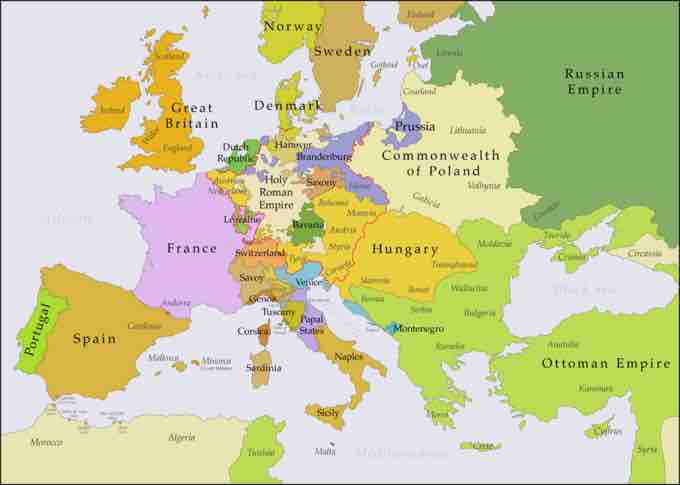The Diplomatic Revolution
In the War of the Austrian Succession (1740-1748), Frederick the Great of Prussia seized the prosperous province of Silesia from Austria. Maria Theresa of Austria had signed the Treaty of Aix-la-Chapelle in 1748 in order to gain time to rebuild her military forces and forge new alliances. The War of the Austrian Succession had seen the belligerents aligned on a time-honored basis. France’s traditional enemies, Great Britain and Austria, had coalesced. Prussia, the leading anti-Austrian state in Germany, had been supported by France. Neither group, however, found much reason to be satisfied with its partnership: British subsidies to Austria produced nothing of much help to the British, while the British military effort had not saved Silesia for Austria. Prussia, having secured Silesia, came to terms with Austria in disregard of French interests. Even so, France concluded a defensive alliance with Prussia in 1747 and the maintenance of the Anglo-Austrian alignment after 1748 was deemed essential by some British politicians.
The collapse of that system and the aligning of France with Austria and of Great Britain with Prussia constituted what is known as the “diplomatic revolution” or the “reversal of alliances.” This change in European alliances was a prelude to the Seven Years' War.
Background
The diplomatic change was triggered by a separation of interests between Austria, Britain, and France. The 1748 Peace of Aix-la-Chapelle, after the War of the Austrian Succession, left Austria aware of the high price it paid for having Britain as an ally. Maria Theresa of Austria had defended her claim to the Habsburg throne and had her husband, Francis Stephen, crowned Holy Roman Emperor in 1745. However, she had been forced to relinquish valuable territories in the process. Under British diplomatic pressure, Maria Theresa ceded Parma to Spain and, more importantly, the valuable state of Silesia to Prussia. The acquisition of Silesia further advanced Prussia as a great European power, which now posed an increasing threat to Austria's German lands and to Central Europe as a whole. The growth of Prussia, dangerous to Austria, was welcomed by the British, who saw it as a means of balancing French power.

This map shows Europe in the years after the Treaty of Aix-la-Chapelle 1748 and the Seven Years' War (1756-1763). The red line marks the borders of the Holy Roman Empire.
Although the War of Austrian Succession concluded with the Treaty of Aix-la-Chapelle (1748), nearly all major powers involved were not satisfied with its outcome. The fragile peace eventually resulted in the diplomatic revolution and collapsed when the Seven Years' War began only eight years after the treaty was signed.
British-Prussian Alliance VS. Austrian-French Alliance
The results of the War of Austrian Succession were clear that Britain no longer viewed Austria as powerful enough to check French power but was content to build up other states like Prussia. Therefore, Britain and Prussia, in the Westminster Convention of 1756, agreed that Britain would not aid Austria in a renewed conflict for Silesia if Prussia agreed to protect Hanover (which remained in personal union with Britain) from France. Britain felt that with Prussia's growing strength, it would be more apt to defend Hanover than Austria. Meanwhile, Austria was determined to reclaim Silesia so the two allies found themselves with conflicting interests. Maria Theresa, recognizing the futility of renewed alliance with Britain, knew that without a powerful ally (such as France), she could never hope to reclaim Silesia from Frederick the Great.
Maria Theresa sent her foreign policy minister, Count Wenzel Anton von Kaunitz, to France to secure an alliance to enable Austria to reclaim Silesia. Louis XV proved reluctant to agree to any treaty presented by Kaunitz. Only with renewed aggression between France and Britain was Louis convinced to align with Austria. Furthermore, Austria no longer surrounded France so France no longer saw Austria as an immediate threat. Consequently, it entered into a defensive alliance with Austria. In response to the Westminster Convention, Louis XV’s ministers and Kaunitz concluded the First Treaty of Versailles (1756). Both sides agreed to remain neutral and to provide 24,000 troops if either got into conflict with a third party.
Maria Theresa's diplomats, after securing French neutrality, actively began to establish an anti-Prussian coalition. Austria's actions alerted Frederick, who decided to strike first by invading Saxony, commencing the Seven Years' War (1756–1763). Frederick's actions were meant to scare Russia out of supporting Austria (the two countries had previously entered into a defensive alliance in 1746). However, by invading Saxony, Frederick had inflamed his enemies. Russia, under the direction of Empress Elizabeth, sent an additional 80,000 troops to Austria. One year after the signing of the First Treaty of Versailles, France and Austria signed a new offensive alliance, the Second Treaty of Versailles (1757).
In 1758, the Anglo-Prussian Convention between Great Britain and the Kingdom of Prussia formalized the alliance between the two powers. However, the alliance proved to be short-lived largely because Britain withdrew financial and military support for Prussia in 1762. The dissolution of the alliance and the pre-eminent rise of Britain left it with no allies by the time the American Revolutionary War broke out.